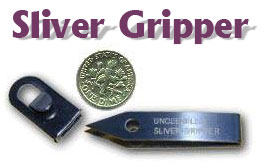Sterilize tweezers or needles with alcohol. To use tweezers to help remove the splinter, disinfect them with rubbing alcohol. This can remove bacteria that may cause infection to your skin.
- You can get rubbing alcohol at pharmacies and many medical supply stores. Grocery stores and large retailers also sell rubbing alcohol.
Employ a magnifying glass and good lighting. One thing to consider is using a magnifying glass when removing the splinter. This may help you see the splinter more clearly and reduce the risk of injuring your skin further. In addition, make sure you remove the splinter in a well-lit area to help you see it better.
Break and lift the skin over the splinter. Using your pin point precision tweezer, break and lift the skin flap that rests over the splinter. This can help you more easily grab the splinter and remove it more quickly.
- If you have to dig deeply to break the skin or see the splinter, consider going to the hospital or your doctor to reduce your risk of injury.
- Breaking the skin and lifting the skin should expose the tip of the splinter.
Grasp the splinter with tweezers. Once you’ve exposed the splinter’s tip, grasp it with your tweezers. Gently pull out the splinter.
- Pull out the splinter at the same angle that it entered your skin.
- If you have to dig deeply with your tweezers to get at the splinter, you may want to see your doctor to remove it.
- If the tip of the splinter breaks off, you may need to either see a doctor or try re-grasping it with your tweezers.
- You can generally remove splinters that entered the skin horizontally and are fully exposed by opening the skin with a sterile needle and flicking it out.
Squeeze the wound gently. When you’ve successfully removed the splinter, gently squeeze it until you see some blood (if it’s deep enough to bleed). This will wash out germs from the wound.
- Don’t be too vigorous. If the wound doesn’t bleed, you can use other methods to clean out any germs and bacteria, including antibacterial ointment.
Disinfect the area. Wash the area where the splinter was after you’ve taken it out of your skin. This can clean any lingering bacteria and germs in the wound. Afterwards, apply an anti-bacterial ointment.
- You can use a mild soap and water or an anti-bacterial wash to disinfect the affected area.
- Pat the area dry with a towel. Don’t rub, which can irritate your skin.
- Apply an antibiotic ointment. Put an antibacterial ointment on the area g up to twice per day. This can minimize the risk of infection on the affected area.
- Purchase an antibiotic ointment such as bacitracin, neomycin, or polymyxin B. Many brands will put the three into one product and call it “triple antibiotic ointment.”
- Cover the area with a bandage if you like.
- Use the ointment as indicated on the packaging.
- You can by antibiotic ointments at most pharmacies and some grocery stores.
Watch for signs of infection. If you start to experience any signs of infection from the site on which you removed the splinter, see your doctor immediately. She can prescribe a course of treatment and remove and lingering bits of the splinter that you were not able to see. Signs of an infection include:
- Drainage from the site
- Pain
- Redness or red streaks on the area
- Fever
